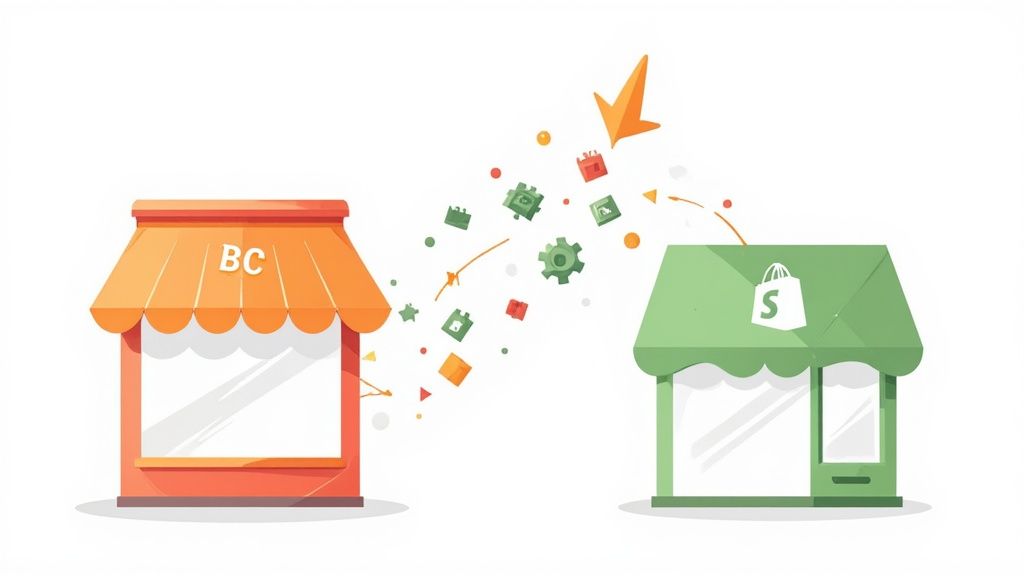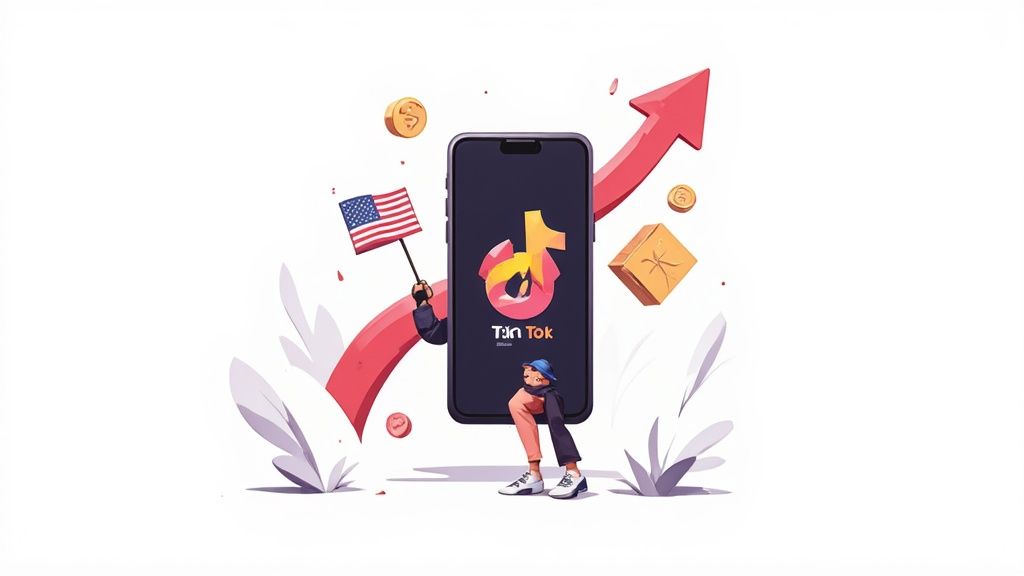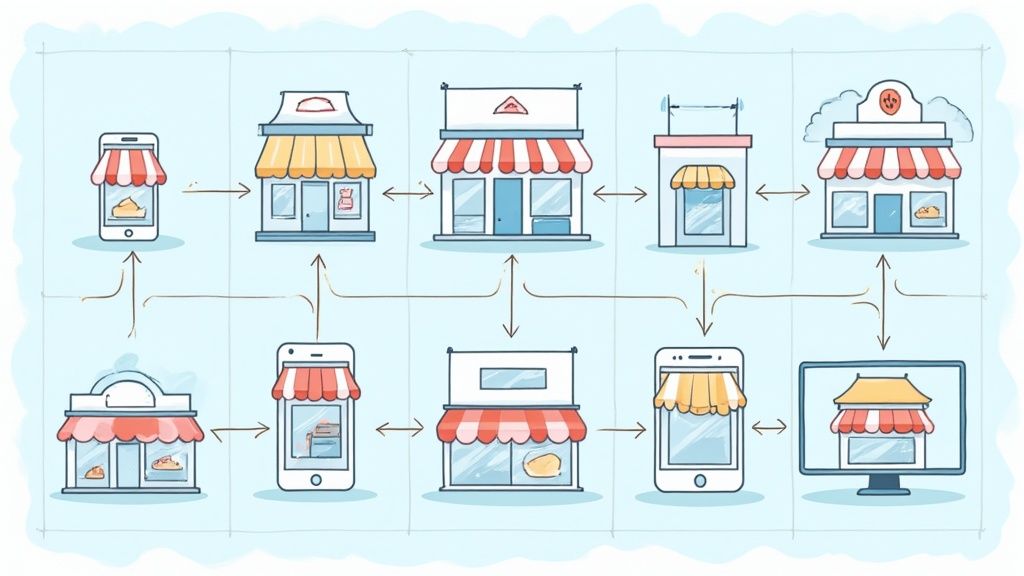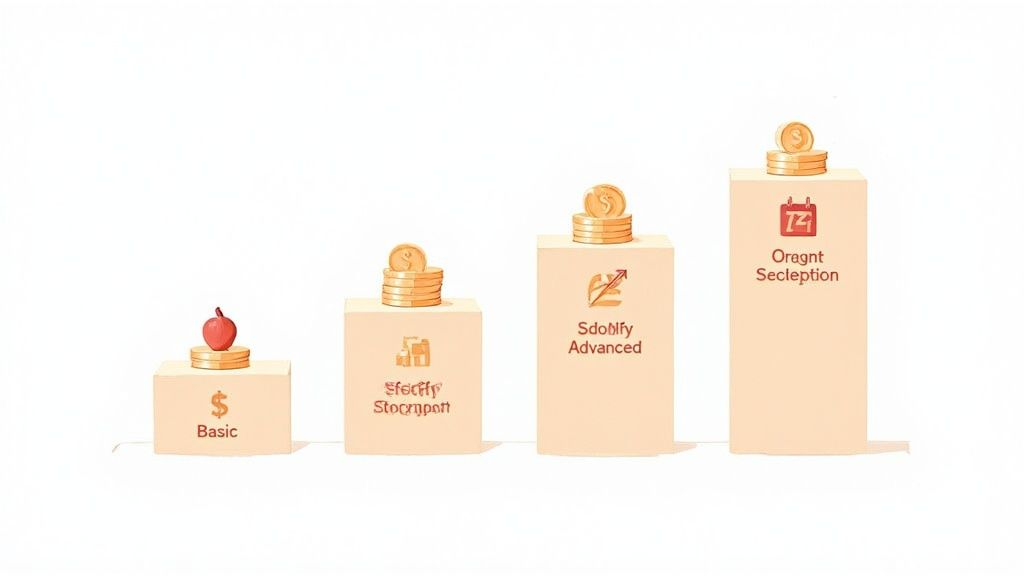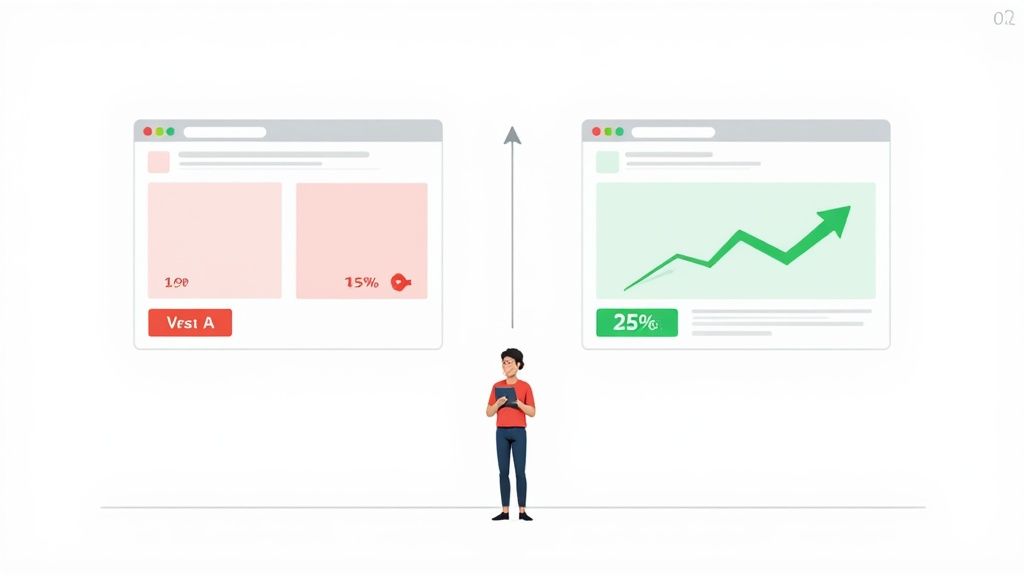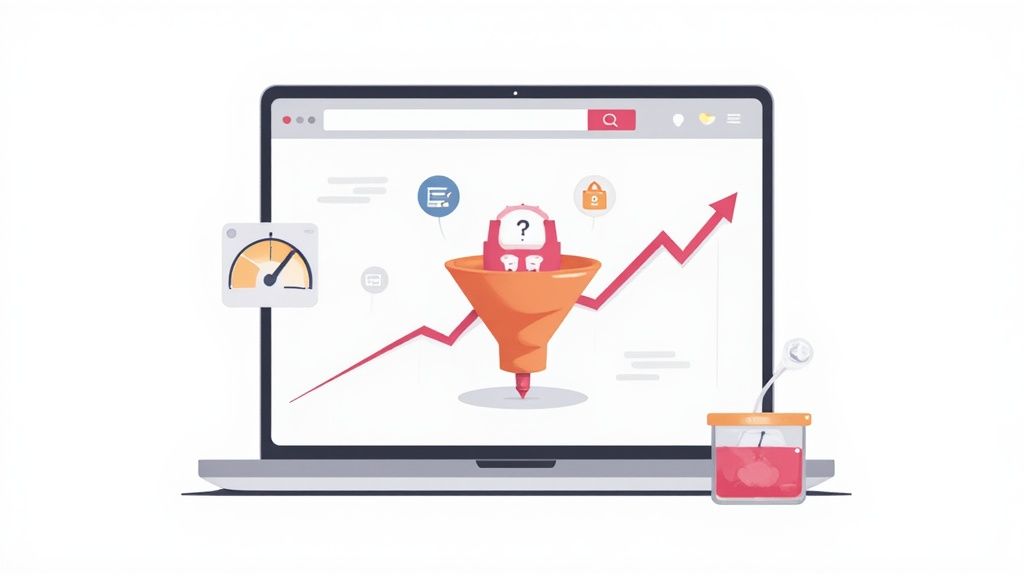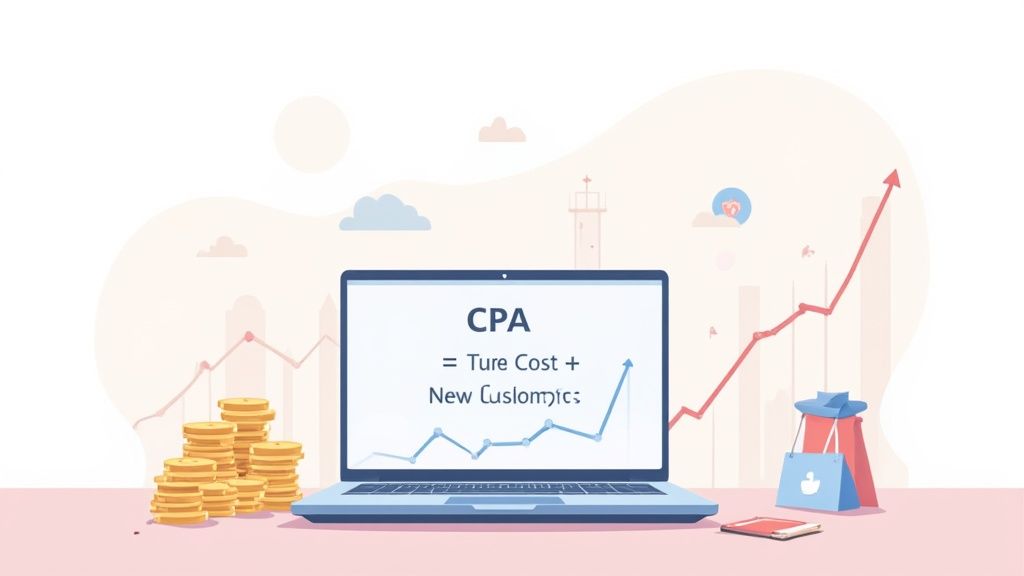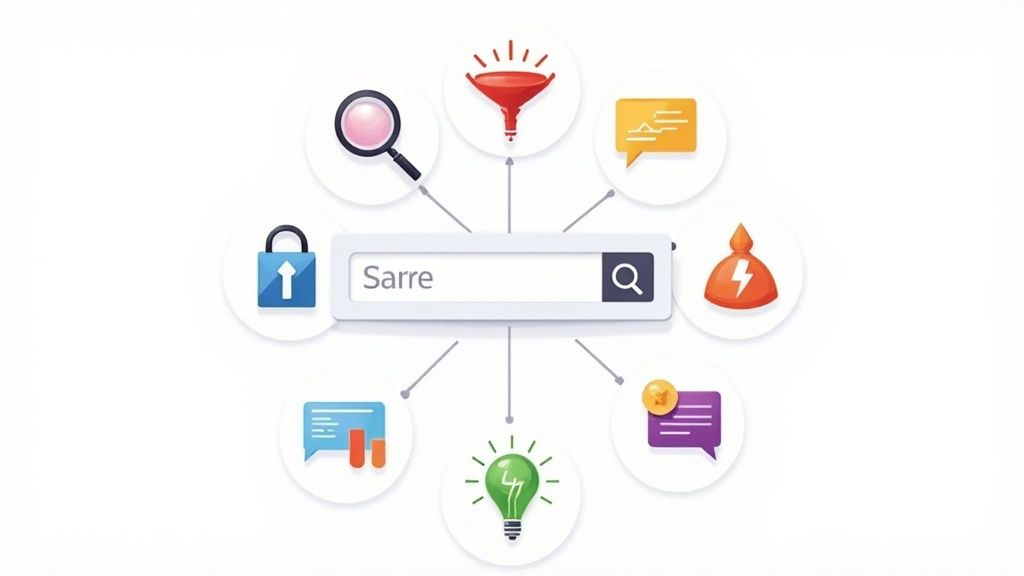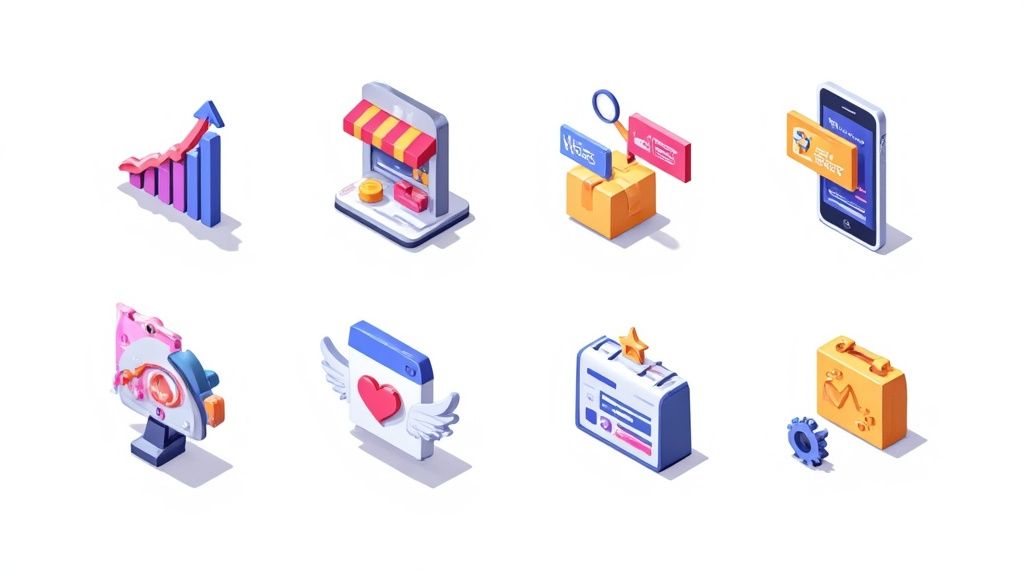
Ever heard of multivariate testing, or MVT? It’s a way to test a bunch of changes on a single webpage all at once to see which combination delivers the best results.
Think of it like trying to bake the perfect cookie. With a simple A/B test, you might test a chocolate chip recipe against an oatmeal raisin one. With multivariate testing, you’re testing three different types of flour, two kinds of sugar, and four different mix-ins all at the same time. The goal is to find that one magic combination that makes the absolute best cookie.
Getting to the Core of It

So what’s really going on here? At its heart, multivariate testing is all about understanding the interaction effect between different elements on your page. Sometimes, a new headline only really pops when it's paired with a specific hero image. An A/B test would never tell you that—it can only test one thing at a time. MVT, on the other hand, is built to uncover these subtle but powerful relationships.
This approach is a cornerstone of any serious Conversion Rate Optimization (CRO) strategy. Instead of just guessing which changes might work together, MVT gives you the data to see how different variables actually influence one another and, ultimately, what drives your customers to act.
By testing elements in combination, MVT moves beyond simple "what works" questions and starts answering "why it works," giving you a much richer understanding of your audience.
Where Did This Idea Come From?
Believe it or not, this isn't some brand-new marketing fad. The concept has surprisingly deep roots in mathematics. The groundwork was laid way back in 1776 when mathematician Joseph-Louis Lagrange first worked out a multivariate technique. That early statistical work is the direct ancestor of the powerful optimization tools we use today.
By using MVT, you get a much more detailed view of your webpage’s performance. You can start answering the really important questions, like:
- Which headline actually has the biggest impact on sign-ups?
- Does a red button convert better than a green one? And does that change if I alter the button text?
- How do my product images affect the click-through rate on my call-to-action?
When you start exploring these combinations, you can make small, data-backed tweaks that add up to massive gains over time. No more guesswork—just pure, actionable data.
Comparing A/B Testing and Multivariate Testing
So you’re looking to improve conversions. That’s where testing comes in, but which kind? While A/B testing and multivariate testing both get you there, they take completely different roads.
Think of it this way: A/B testing is like a heavyweight boxing match, while MVT is more like a complex chess match. One is about a direct, powerful comparison; the other is about strategy and the interplay of many pieces.
An A/B test (or split test) is simple and direct. It pits two totally different versions of a page against each other to see which one performs better. For example, you might test a product page with one huge, stunning hero image against a version with a carousel of smaller, detailed shots. It’s a clean, head-to-head comparison focused on a single, major change.
Multivariate testing, however, is built to analyze a bunch of smaller changes all at once, and more importantly, how they interact with each other. It moves beyond asking "which page is better?" and starts asking, "which combination of elements creates the absolute best version of this page?" This is where you get much deeper insights into what your customers actually want.
Scope and Focus: The Key Differences
The biggest distinction between the two is their scope. A/B testing is your go-to when you're testing big, bold, high-impact changes and you need a clear winner. Thinking about a complete checkout page redesign? That’s a perfect job for an A/B test. You’re comparing two fundamentally different experiences.
If you want to dig deeper into the "why" behind your test results, check out our detailed guide on A/B testing best practices.
Multivariate testing shines when you're fine-tuning an already solid design. Let's say you want to perfect a product page by testing:
- Two headlines: "Luxury Leather Wallet" vs. "Handcrafted for Durability"
- Three button texts: "Add to Cart," "Buy Now," and "Get Yours Today"
- Two image styles: A product on a white background vs. a lifestyle shot
This setup doesn’t create just a few variations; it creates 12 unique combinations (2 headlines x 3 buttons x 2 images = 12) that are all tested simultaneously. MVT won't just tell you that "Buy Now" is the best button text. It might reveal that "Buy Now" performs exceptionally well, but only when it's paired with the "Handcrafted for Durability" headline and the lifestyle photo. That's a level of detail an A/B test could never give you.
An A/B test tells you which page won. A multivariate test tells you why a specific combination of elements created a winner.
To make this crystal clear, here’s a quick breakdown of how these two testing methods stack up against each other.
A/B Testing vs. Multivariate Testing at a Glance
This table should help you quickly decide which approach fits your current needs, but let's dive into the specific scenarios for each.
When to Choose Each Method
Your choice really boils down to your goals, your traffic volume, and the kind of change you’re trying to make.
- Choose A/B Testing When: You're testing a completely new design, have one major element you want to change (like your core value proposition), or you have lower website traffic. It’s perfect for getting quick, straightforward answers to big-picture questions.
- Choose Multivariate Testing When: You want to refine an existing high-performing page, understand how several small elements work together, and have enough traffic to spread across many variations without waiting forever. MVT is the tool for incremental gains and deep user insight.
How Multivariate Testing Actually Works
At its heart, multivariate testing (MVT) is really just a sophisticated game of mix-and-match. Instead of comparing two completely different pages like you would in an A/B test, MVT breaks a single page down into its core components. Then, it methodically tests every single possible combination to see which mix delivers the best results.
Let’s say you’re looking at your product page. You want to test two different headlines and three different call-to-action (CTA) button texts. An MVT platform will automatically generate every version for you:
- Headline 1 + CTA Text 1
- Headline 1 + CTA Text 2
- Headline 1 + CTA Text 3
- Headline 2 + CTA Text 1
- Headline 2 + CTA Text 2
- Headline 2 + CTA Text 3
That gives you six unique combinations (2 x 3 = 6) to test. Your website traffic gets split evenly among all six, and the test tracks which specific recipe gets the most people to click "buy." This infographic really drives home the difference between the two approaches.
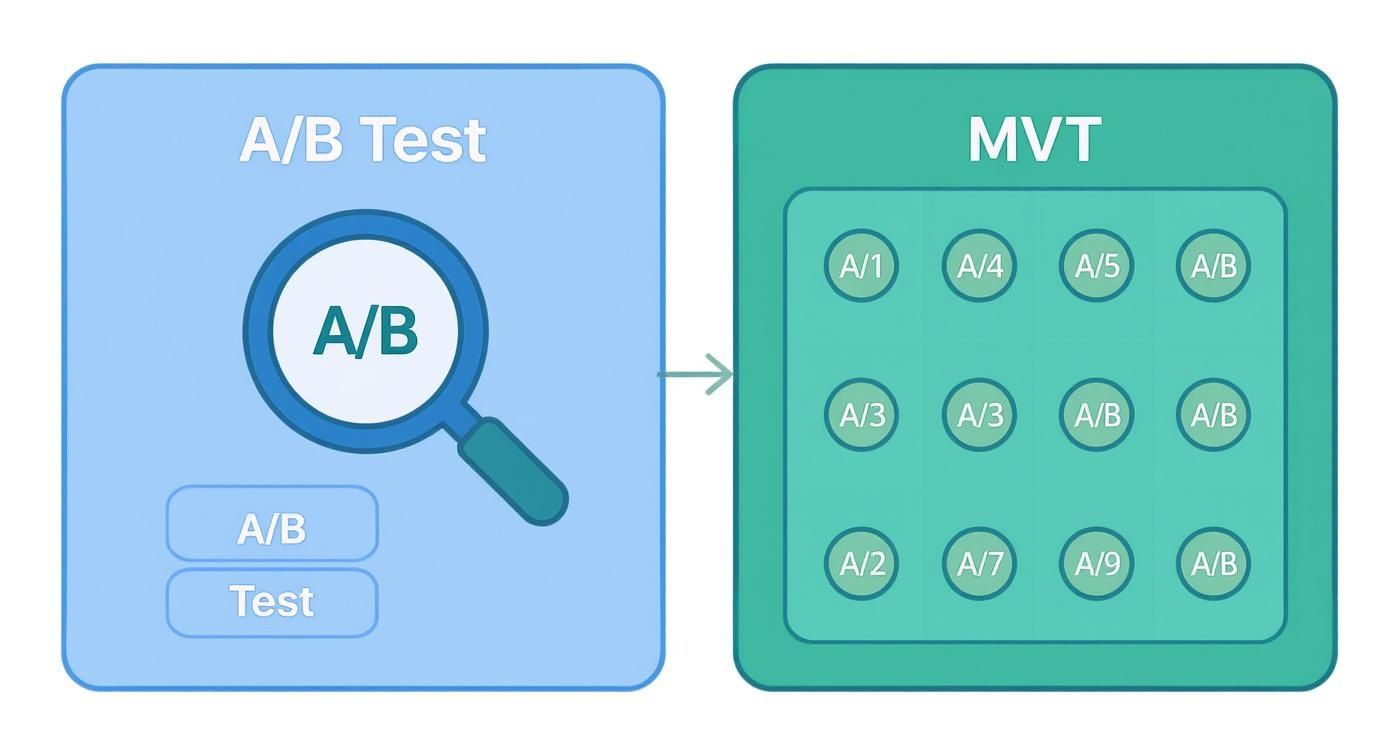
You can see how A/B testing is a straight one-on-one comparison. MVT, on the other hand, is a grid—perfectly illustrating how it juggles multiple interactive elements at the same time to find the winning formula.
Finding the Winner With Data
So, how does the test pick a "winner"? It all boils down to statistical significance. That might sound intimidating, but the concept is pretty simple: it’s the point where you’re confident your results aren't just a fluke. Thankfully, modern testing tools do all the heavy math for you. They watch how visitors behave on each version until one combination consistently outperforms the rest by a meaningful margin.
The real beauty of MVT is that the software does the hard work. Your job isn't to be a statistician—it's to interpret the results and make smart, data-backed decisions that improve your store.
The great part is, you don’t need to manage any of this complexity yourself. With the right conversion optimization tools, you can stay focused on coming up with creative ideas and let the technology tell you what actually resonates with your audience.
Understanding the High Traffic Requirement for MVT
Multivariate testing is an incredibly powerful tool, but it has one major catch: it’s hungry for traffic. A lot of traffic.
Think of your website visitors as a pie. In a simple A/B test, you’re just cutting that pie in half. But with MVT, you have to slice that same pie into a piece for every single combination of elements you're testing.
Let's say you want to test two headlines, two images, and two call-to-action buttons. That's not three or four variations—it’s eight (2 x 2 x 2 = 8). If you get 8,000 visitors, each unique version of your page is only seen by 1,000 people. Your data gets spread incredibly thin, making it tough to find a clear, statistically significant winner.
Why Small Traffic Pools Are Risky
Trying to run MVT on a low-traffic site is like trying to fill a swimming pool with a garden hose. It’s slow, inefficient, and you might give up before you get anywhere. When each variation only gets a trickle of visitors, you're setting yourself up for failure.
- Inconclusive Results: You could let the test run for weeks or even months, only to find that you still don't have enough data to declare a winner.
- False Positives: With small sample sizes, random luck can easily look like a winning trend. You might implement a change that does nothing for your conversions—or worse, actually hurts them.
- Wasted Resources: Every day a test runs, you're splitting your traffic instead of sending everyone to your best-performing page. That's a direct hit to your time and potential revenue.
In short, MVT is a numbers game. Without a big enough audience, you're not collecting meaningful data; you're just collecting noise. And making business decisions based on noise is arguably worse than just going with your gut.
How Much Traffic Is Enough?
So, what’s the magic number? While it varies, a common rule of thumb is to have at least 10,000 monthly visitors to the specific page you want to test. But honestly, that’s just a starting point.
The real number depends on your current conversion rate and how many combinations you're running. For instance, a site with 5,000 daily visitors and a 2% conversion rate could need a mind-boggling 468 days to get a reliable result for just a single variation. You can dig into a deeper analysis of MVT traffic requirements here.
This chart does a great job of showing just how quickly your traffic needs can spiral as you add more variations to the mix.

The key takeaway is that the relationship isn't linear. Adding just one more element can exponentially increase the traffic you need to get a clear answer in a reasonable amount of time. Always use a sample size calculator before you even think about launching a multivariate test. It will save you a world of headache.
What You Actually Gain From Multivariate Testing
Going beyond the vague goal of "improving conversions," multivariate testing gives you specific, powerful advantages that take all the guesswork out of your optimization strategy. It basically turns your website from a static storefront into a dynamic lab where you're constantly learning what actually makes your customers tick.
The insights you get aren't just theoretical fluff; they translate directly into a better user experience and, more importantly, a healthier bottom line. You get to build a website based on proven user behavior, not just the latest design trends or your own gut feelings.
Uncover Powerful Interaction Effects
The single biggest win from multivariate testing is its ability to spot interaction effects. This is a fancy way of saying you can see how one element's performance changes when you mess with another element. A simple A/B test can't do this, since it only ever looks at one change at a time.
Let's say you're testing a new headline and a new hero image. An A/B test might tell you the new headline bombed. But MVT could reveal that the new headline is actually a massive winner, but only when it’s paired with your original hero image. That’s a game-changing insight that keeps you from throwing out a great idea just because you tested it in the wrong combination.
Drive Compounding Incremental Gains
Success in ecommerce is often a game of inches, not miles. Multivariate testing is tailor-made for this reality, letting you lock in small, steady improvements that add up over time. You might find that a tiny tweak to your button text bumps up add-to-carts by 1.5%, and a different product description gives you another 2%.
On their own, those numbers don't look like much. But when you combine them and keep building on them for months, they create a serious lift in your overall conversion rate. It's a disciplined way to optimize that builds real, lasting momentum.
By focusing on the interplay between elements, MVT helps you refine your user experience with surgical precision, ensuring every part of your page works in harmony to drive action.
Maximize Your Traffic ROI
Think about all the time and money you pour into driving traffic to your store through ads, SEO, and social media. Every single visitor who clicks away without buying is a lost opportunity and wasted ad spend. MVT helps you squeeze more value out of the visitors you already have.
Instead of just paying more to get new eyeballs on your site, you can boost revenue by converting a higher percentage of your existing traffic. For instance, finding a magic combination of a trust badge, CTA text, and shipping info that lifts conversions by 12% means you’re making more money from the exact same marketing budget. This is where the benefits get really tangible, helping you implement proven strategies for improving website conversion rates. That kind of efficiency makes your entire marketing operation more profitable.
Seeing Multivariate Testing in Action
Theory is one thing, but seeing how multivariate testing solves real-world problems is where it all clicks. Let's move from abstract concepts to a couple of concrete examples to show you what this looks like on the ground.
Picture an online clothing store looking to squeeze more performance out of its best-selling product page. They have a few hunches about what might work better, but instead of just guessing, they decide to run a multivariate test.
The team zeroes in on three key elements they think will move the needle:
- Product Description: They want to test a short, punchy paragraph against a simple bulleted list of features, and a more detailed, story-driven description.
- CTA Button Text: Is the standard "Add to Cart" better, or does "Add to Bag" create a little more urgency?
- Trust Badge: They wonder if adding a "100% Secure Checkout" badge makes a difference, so they test a version with it against one without.
This setup creates a total of 12 unique combinations for visitors to see (3 descriptions x 2 CTAs x 2 badge options). After letting the test run for three weeks, the data points to a clear winner.
The combination of the bullet-point description, the "Add to Bag" CTA, and the secure checkout badge boosted conversions by a massive 18%. They learned that for their audience, a recipe of clarity, urgency, and reassurance was the ticket.
How a SaaS Company Optimized Its Pricing Page
Now, let’s switch gears to a completely different business model: a Software-as-a-Service (SaaS) company. Their goal is to get more people to sign up for a free trial from their pricing page.
They set up a multivariate test to explore a few variables:
- Headline: They pit a benefit-driven headline ("Start Growing Your Business Today") against a more feature-focused one ("Powerful Tools for Every Team").
- Plan Layout: A traditional vertical layout of pricing tiers versus a horizontal, side-by-side comparison.
- Social Proof: A customer testimonial quote versus a row of logos from well-known clients.
The results were fascinating. The test revealed that the benefit-driven headline paired with the horizontal plan layout and the client logos was the winning formula, increasing free trial sign-ups by an impressive 22%.
In both of these cases, the businesses didn't just find a single winning element. They discovered the most effective recipe of elements working together. This is the kind of insight that unlocks growth you'd likely miss with simple A/B testing alone, helping you move beyond hunches to build better experiences based on hard data.
Got Questions About Multivariate Testing?
Even after getting the basics down, a few practical questions usually pop up right before you hit "launch" on your first MVT experiment. Getting these details right is the difference between murky data and a clear, actionable winner. Let's tackle the most common ones.
The big takeaway here is that testing isn't just about throwing ideas at the wall to see what sticks. It's a methodical process designed to give you concrete answers about what your customers actually want.
How Long Should a Multivariate Test Run?
There's no magic number. Forget about a fixed number of days; your timeline depends entirely on your traffic volume and conversion rate. The real goal is to reach statistical significance, which is just a fancy way of saying you're confident the results are due to your changes, not just random luck.
For a high-traffic Shopify store, you might get a clear winner in just a couple of weeks. But for a smaller site, it could easily take a month or even longer. Don't worry, most testing tools will flag when you've collected enough data to make a reliable call.
As a rule of thumb, always run a test for at least one full week. This helps smooth out any weird fluctuations between weekday and weekend shopping behavior.
What Are the Best Elements to Test on a Page?
Want the biggest bang for your buck? Focus on the elements closest to the money—the ones that directly influence a user's decision to buy or sign up. Seriously, don't waste time A/B testing the color of a link in your footer.
Here’s where to focus:
- For an e-commerce product page: Test the headline, product images, call-to-action (CTA) button (both text and color), the product description, and trust signals like security badges or customer reviews.
- For a lead generation page: Zero in on the main headline, the form itself (how many fields?), the CTA copy, and social proof like testimonials or company logos.
By testing high-impact elements, you ensure your MVT efforts are focused on changes that can meaningfully lift your key metrics, rather than chasing minor, insignificant tweaks.
Can I Use MVT on a Low-Traffic Website?
Honestly, you probably shouldn't. MVT works by splitting your traffic among many different combinations. If your site doesn't get a ton of visitors, each variation will only receive a tiny trickle of traffic.
This makes it almost impossible to get trustworthy results in a reasonable amount of time. You could be waiting months for an answer.
For websites with lower traffic—a common benchmark is under 30,000 monthly visitors—A/B testing is a much smarter move. It concentrates all your valuable traffic on just two versions, giving you a clear winner much, much faster.
Ready to stop guessing and start optimizing with data-driven precision? The team at ECORN specializes in conversion rate optimization for Shopify stores, turning your traffic into revenue. Let's build a higher-converting store together.











